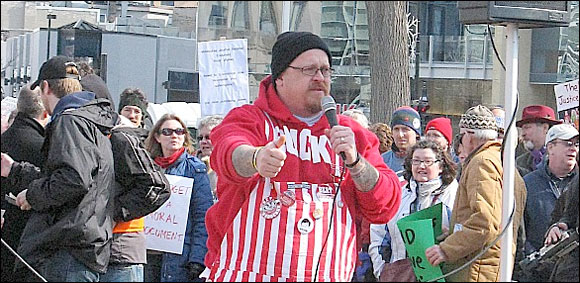 OWS’s new People’s Microphone is quite simply a Neuro-Linguistic Programming (NLP) application or technique. Its consensus arrival method, also known as “call-and-return”, has now become the audio device of choice- spreading across the country as quickly as the protests themselves.
OWS’s new People’s Microphone is quite simply a Neuro-Linguistic Programming (NLP) application or technique. Its consensus arrival method, also known as “call-and-return”, has now become the audio device of choice- spreading across the country as quickly as the protests themselves.Crowd participants slowly repeat each phrase the leading speaker is saying to them, with a series of hand signs used to provide the speaker and the group with feedback.
To the casual observer, this new system of communication may appear as compelling, as it is metaphoric. It might also remind you of the infamous ‘pass the conch’ scene from the Nobel Prize-winning novel by William Golding, Lord of the Flies.
It is a very slow and tedious process, often resulting in very few actual issues being fleshed out. In most cases, it takes triple the amount of time to convey the same amount of information that a normal speaker would accomplish by talking directly to the audience. But this can only be done when the group is forced to repeat the words of the speaker, so the speaker is forced to talk slowly, using fewer words at once. In this way, it is also a mesmerizing and extremely hypnotic group communication tool.
In this way, such NLP methods can also be used to promote ‘group-think’ and could be described as collectivist mind control education at its very finest.
Successful NLP systems like this are commonly used by sales people in business, as well as in advertising and of course politics, working in restricted bloc of words, and often with restricted vocabularies.
Group moderators insist that this is done so that ‘everybody is safe’, and that the group is ‘doing things properly’. Any interaction with a speaker can only be done by employing a series of parochial child-like hand-signs, normally reserved for children attending school in K-8 grades.There is certain appeal to ‘being part of the community’, where group leaders will ask the crowd for a ‘temperature check’ in order to determine “how ‘the bloc’ feels about what someone has said”, and if what someone is in consensus with “the bloc”. The audience will offer up a hand signal of waiving both hands to show their approval.
Once a consensus is identified, it’s typical that members of “the bloc” will feel that they are part of the collective, and thus, “part of the change”.
Unfortunately, in this type of system most of the group have little idea of what they are actually repeating, or who and what they are supporting with their hand signals, waving their hands, or making a triangle sign to communicate. link
No comments:
Post a Comment